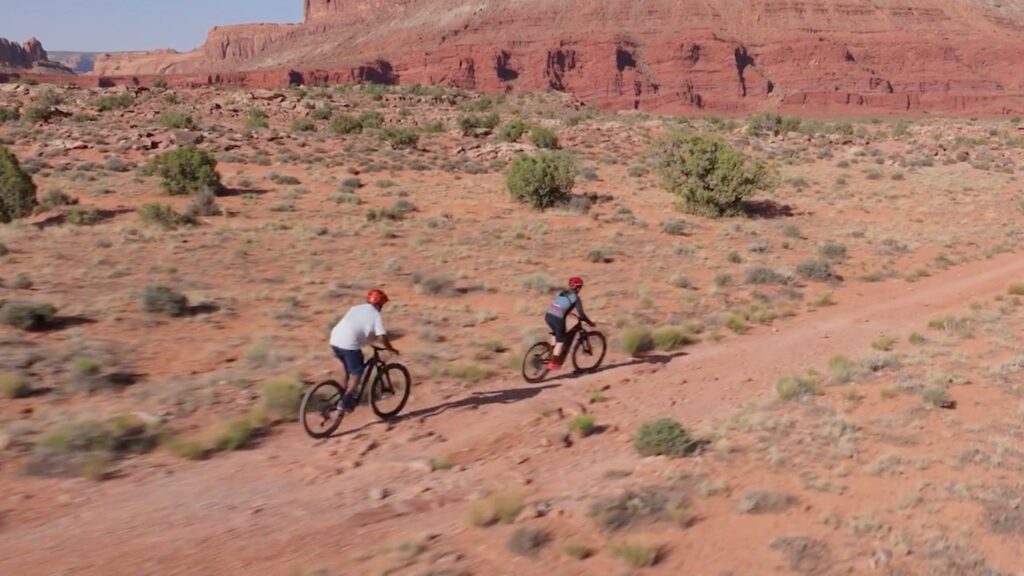Find Food Truck Park, unique quesadillas, and “wine of a thousand flavors” in this outdoorsy paradise
(Photo: The Road Less Eaten)
Updated August 1, 2025 02:10PM
In the latest episode of The Road Less Eaten, chef and host Biju Thomas visits Moab, Utah, an old mining site turned into a mountain bikers’ dream town. MTBers and off-roaders discovered Moab after uranium extraction slowed down in the eighties. With hundreds of trails surrounded by beautiful red rock, millions of people pass through each year to visit the mountain biking mecca, and for many, the food scene is what keeps them hanging around.
“Moab isn’t just feeding the crowds, it’s starting to impress them,” Thomas says as Ashley Korenblat, co-owner of Western Spirit Cycling, gives him the historic run down of the beautiful, wild trails in front of them.
After a lesson on the fragility of the Moab’s desert ecosystem, Thomas and Ashley head to its Food Truck Park for lunch.
Moab Food Truck Park
Thomas and Korenblat first stop by Quesadilla Mobilla, owned and operated by Carrie Finn, who opened the first truck on the Food Truck Park grounds in 2012. Finn first traveled to the Moab desert to climb at Indian Creek. As a rock climber, she would grill up quesadillas for friends who thought they were good enough to sell. Finn ultimately took their advice and started her quesadilla truck in town.
In the show, Thomas points out an “earthiness” flavor to her food, which Finn says comes from the umami in it. What makes her quesadillas unique, are the red chilis she buys from Chimayó, New Mexico.
The town favorite, the southern bell, is packed full of red chilis, shredded pork, and spicy roasted sweet potatoes.

Next, Thomas and Korenblat stop by Wrap it Up, a part Mediterranean-inspired, part Turk- and Lebanese-inspired gyro spot in the Food Truck Park. Wrap It Up is owned by Baris and Nuray Karatas who ventured to Moab on vacation five to six years ago, and decided to stay.
Spanish Valley Vineyards
Spanish Valley Vineyards yields “wine of a thousand flavors,” Russ Reali, general manager of the vineyards shares with Thomas as the two walk the grounds of what became Moab’s way to fuel the economy after the Cold War.
A bunch of grape vines were started, and 50 years later, their wines still sell out fast.
Reali ventured to Moab as a rock climber and took a job trimming the fields on one of his stays. Ultimately, Reali settled into the valley and was given the torch of managing the fields. Like so many others who have settled in Moab, Reali is a passionate person who loves working on small-scale projects that involve an entire community.
There are three things that keep the vineyard thriving in the desert, Russ says: colder nights (30 to 40 degrees Fahrenheit), provided shade, and the fact that when it reaches 95 degrees, the vines stop respirating and photo synthesizing to conserve energy.
Then, Reali walks Thomas through the bottling process. Every bottle is hand prepared in a garage.

The vineyard’s signature flavor is its Cherry Wine, which uses cherries imported from further north.
“Throw in some ice cubes and kick off your shoes,” Thomas says. The taste is tart, but not too sweet.
Sabaku Sushi
Thomas ends his time in Moab rafting down the Colorado River with guide, Jonah Boyer of Wild West Voyages, who also works as a dishwasher at the last restaurant Thomas tours.
“People take for granted solid dish washers in busy restaurants,” Thomas states, admitting to Boyer that he has never been rafting before. Despite some fears, Thomas picks up the oars to learn how to navigate the waters before handing them back over when they hit class two rapids.
“This is the kind of quiet that invites everything else to come out of hiding” Thomas says, pointing out various forms of wildlife before going back to shore to visit Boyer’s place of work: Sabaku Sushi.
Co-owners Alex Borichevsky and Frankie Winfrey were sushi chefs in Salt Lake City, Utah, before settling into Moab where they saw a business opportunity to bring sushi to the desert. The town was prime for a restaurant of this caliber, Borichevsky tells Thomas.
The restaurant combines a love for the desert with exquisite Japanese cuisine. Since Moab is landlocked, Sabaku Sushi gets its fish from all over the world, “by planes and trucks,” Borichevsky says, but you cannot tell, adds Thomas.
Chef Winfrey walks Thomas through making one of the most popular items on their menu: the delicate Arch Roll, wrapped in cucumber and stuffed with salmon, tuna, and crab.

There isn’t rice in the roll, and the sauce poured over is an onion garlic ponzu, one of Thomas’ favorites.
Moab’s got this energy. It’s so special that folks traveling in for the trails sometimes stay forever because of its close-knit community—and the food.


